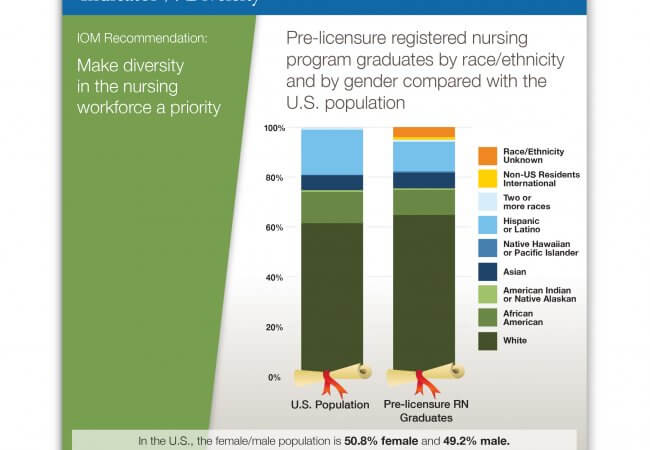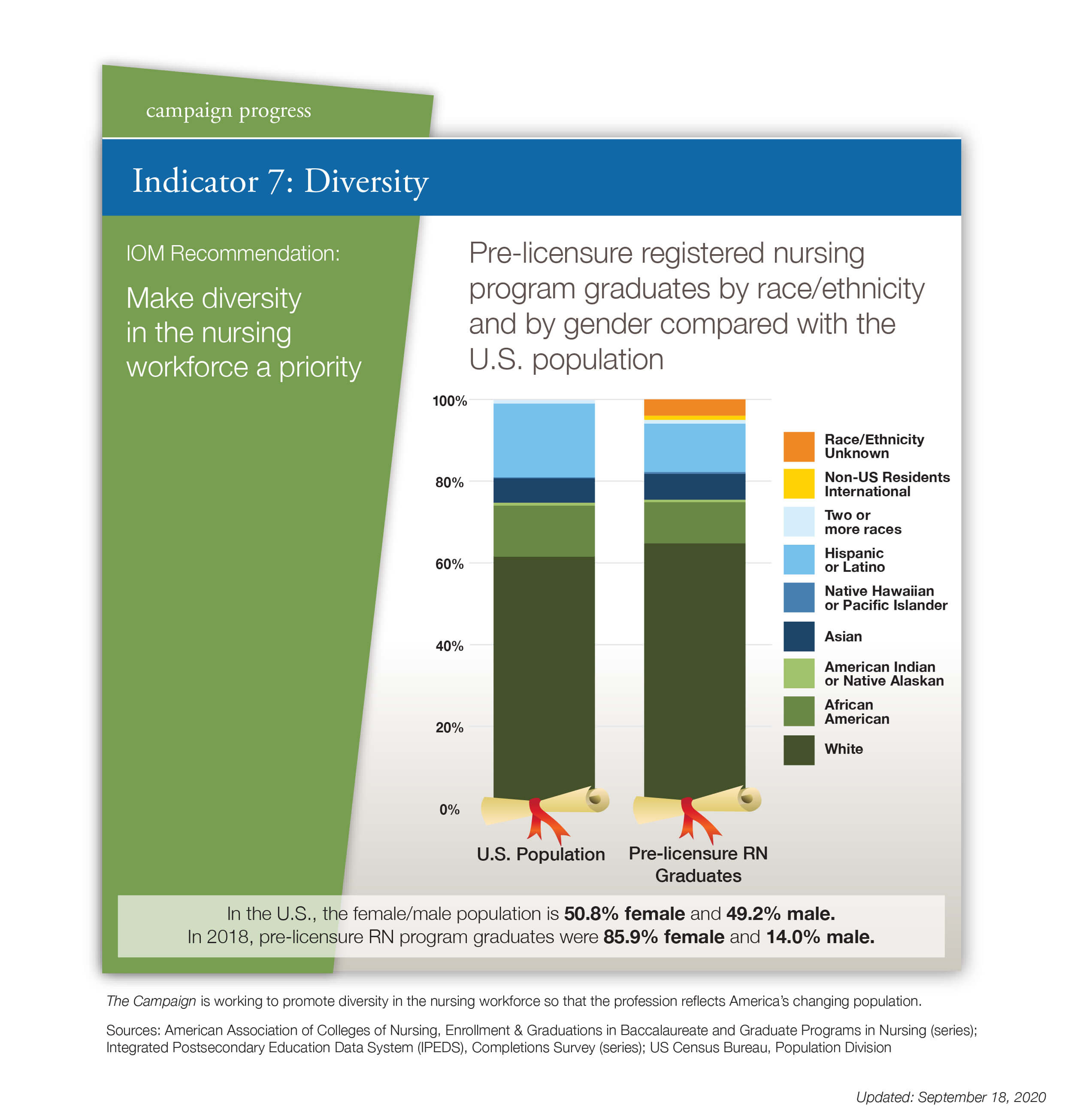
Oct 13, 2020
Nurse Education and Diversity on Rise, Latest Figures Show
Since its beginning in 2010, The Future of Nursing: Campaign for Action has tracked progress made by its state-based Action Coalitions, nurses, and supporters as we continue to implement recommendations made by the Institute of Medicine (IOM; now the National Academy of Medicine) in its Future of Nursing: Leading Change, Advancing Health report. The Campaign established a series of more than two dozen national measures, updated twice a year and presented in a series of graphs and charts, the Dashboard. We do this, so we can regularly measure and report on progress in reaching the IOM goals.
The new numbers are in and indicate progress made in 2019 in advancing nursing education and increasing diversity in nursing. Except where noted, the data covers the years from 2010 to 2019. At the time of data collection, the number of nursing students obtaining associates degrees (ADN) was not available. Data sources are listed below.
Highlights include:
- The number of RN-to-BSN graduates annually has nearly tripled to 65,931, an increase of 193 percent.
- The number of BSN graduates from underrepresented groups more than doubled to 23,538, an increase of 104 percent. These groups include American Indian or Alaskan Native, Asian, Black or African American, Hispanic or Latino, Native Hawaiian or other Pacific Islander, plus those who identify as having two or more races. While this development is promising, we know that the diversity of the nursing workforce does not yet reflect the diversity of the communities it serves.
- The number of male BSN graduates almost doubled to 10,488, an increase of 82 percent.
- The number of entry-level masters (ELM) graduates from underrepresented groups more than tripled to 1,126, an increase of 224 percent. Those groups include American Indian or Alaskan Native, Asian, Black or African-American, Hispanic or Latino, Native Hawaiian or other Pacific Islander, plus those who identify as having two or more races.
- The number of male ELM graduates nearly tripled to 496, an increase of 171 percent.
- The number of people receiving PhD degrees annually jumped to about 800, a 51 percent increase. The number of people receiving Doctor of Nursing Practice (DNP) degrees annually grew to nearly 8,000, a 520 percent increase.
- The number of DNP graduates from underrepresented groups has grown to 2,466, an increase of more than 1,000 percent. These groups include American Indian or Alaskan Native, Asian, Black or African American, Hispanic or Latino, Native Hawaiian or other Pacific Islander, plus those who identify as having two or more races.
- The number of male DNP graduates has increased by more than nine times, to 1,043, an increase of 857 percent.
- The number of PhD graduates from underrepresented groups increased by 137 percent to 220 and the number of male PhD graduates increased by 126 percent to 79. These groups include American Indian or Alaskan Native, Asian, Black or African American, Hispanic or Latino, Native Hawaiian or other Pacific Islander, plus those who identify as having two or more races.
- The number of fall enrollments in nursing doctorate (PhD and DNP) programs increased by 249 percent, with DNP programs experiencing a more than 400 percent increase.
- As of September 14, 7,782 nurses reported their board service to the Nurses on Boards Coalition, an increase of 9.6 percent since January 20, 2020, when there were 7,100 nurses reporting.
- The number of articles published co-authored by an RN that appeared in top health services journals increased by 16 percent.
Below are a few highlights dating from 2011 to 2020:
- The state boards of nursing that participate in the National Council of State Boards of Nursing (NCSBN) Nursys Licensure Quick Confirm data system increased by nearly 19 percent.
- The number of U.S. hospitals with magnet status increased by 118, an increase of 30 percent.
For more information, view the primary Dashboard indicators (which cover progress in seven areas identified in the IOM report) and the secondary Dashboard indicators (which provide further support measures for each primary Dashboard goal). Working with our state-based action coalitions, nurses, and supports, the Campaign is paving the way toward the stronger, better-prepared, and more diverse nursing workforce that our nation needs.
Dashboard Data Sources
| Secondary Indicator: Education Number of RN‐to‐BSN graduates annually |
American Association of Colleges of Nursing, Enrollment & Graduations in Baccalaureate and Graduate Programs in Nursing. (2009-2019). |
| Secondary Indicator: Diversity The number of BSN graduates from underrepresented groups |
American Association of Colleges of Nursing, Enrollment & Graduations in Baccalaureate and Graduate Programs in Nursing. (2009-2019). |
| Secondary Indicator: Diversity The number of male BSN graduates |
American Association of Colleges of Nursing, Enrollment & Graduations in Baccalaureate and Graduate Programs in Nursing. (2009-2019). |
| Secondary Indicator: Diversity The number of entry-level masters (ELM) graduates from underrepresented groups |
American Association of Colleges of Nursing, Enrollment & Graduations in Baccalaureate and Graduate Programs in Nursing. (2009-2019). |
| Secondary Indicator: Diversity The number of male ELM graduates |
American Association of Colleges of Nursing, Enrollment & Graduations in Baccalaureate and Graduate Programs in Nursing. (2009-2019). |
| Secondary Indicator: Doctoral Degrees The number of people receiving PhD degrees annually; the number of people receiving Doctor of Nursing Practice (DNP) degrees annually |
American Association of Colleges of Nursing, Enrollment & Graduations in Baccalaureate and Graduate Programs in Nursing. (2009-2019). |
| Secondary Indicator: Diversity The number of DNP graduates from underrepresented groups |
American Association of Colleges of Nursing, Enrollment & Graduations in Baccalaureate and Graduate Programs in Nursing. (2009-2019). |
| Secondary Indicator: Diversity The number of male DNP graduates |
American Association of Colleges of Nursing, Enrollment & Graduations in Baccalaureate and Graduate Programs in Nursing. (2009-2019). |
| Secondary Indicator: Diversity The number of PhD graduates from underrepresented groups; the number of male PhD graduates |
American Association of Colleges of Nursing, Enrollment & Graduations in Baccalaureate and Graduate Programs in Nursing. (2009-2019). |
| Secondary Indicator: Doctoral Degrees The number of fall enrollments in nursing doctorate (PhD and DNP) programs |
American Association of Colleges of Nursing, Enrollment & Graduations in Baccalaureate and Graduate Programs in Nursing. (2009-2019). |
| Nurses that reported their board service to the Nurses on Boards Coalition | Nurses on Boards Coalition, https://www.nursesonboardscoalition.org/. Accessed September 14, 2020. |
| Secondary Indicator: Interprofessional Collaboration The number of articles published co-authored by an RN that appeared in top health services journals |
Review of selected journals: American Journal of Managed Care, American Journal of Preventive Medicine, American Journal of Public Health, Annals of Behavioral Medicine, Health Service Research, JAMA, Medical Care, Milbank Quarterly, New England Journal of Medicine. (2010-2019) |
| Secondary Indicator: Workforce Data The state boards of nursing that participate in the National Council of State Boards of Nursing (NCSBN) Nursys Licensure Quick Confirm data |
National Forum of State Nursing Workforce Centers. (2010-2019). Health Workforce Technical Assistance Center, Data Collection Inventory. (2010-2019). Direct contact with state-level representatives. |
| Secondary Indicator: Education The number of U.S. hospitals with magnet status |
American Nurses Credentialing Center. (2010-2019). American Hospital Association Annual Survey. (2010-2018). |

